Car scan tools are vital for diagnosing Variable Valve Timing (VVT) system faults by reading diagnostic trouble codes (DTCs) and providing live data, enabling technicians to pinpoint issues efficiently. At CAR-SCAN-TOOL.EDU.VN, we emphasize the importance of comprehensive training to fully leverage these tools for accurate diagnostics and repairs. Investing in specialized automotive scanner training and remote technician education enhances diagnostic capabilities and ensures effective VVT system maintenance.
Contents
- 1. What Is Variable Valve Timing (VVT) and Why Is It Important?
- 2. What Role Does the VVT Solenoid Play in the System?
- 2.1. Benefits of a Properly Functioning VVT Solenoid
- 2.2. Why a Faulty VVT Solenoid Impacts Engine Performance
- 3. What Are the Common Causes of VVT Solenoid Failure?
- 3.1. The Role of Regular Maintenance in Preventing VVT Solenoid Issues
- 3.2. Impact of Harsh Operating Conditions on VVT Solenoids
- 4. What Symptoms Indicate Potential VVT Solenoid Problems?
- 4.1. What Are the Specific Engine Performance Issues Associated with VVT Malfunctions?
- 4.2. Why is Early Detection of VVT Issues Crucial?
- 5. How Do Car Scan Tools Aid in Diagnosing VVT Solenoid Problems?
- 5.1. Reading Diagnostic Trouble Codes (DTCs) Related to VVT Systems
- 5.2. Utilizing Live Data to Assess VVT System Performance
- 5.3. Additional Diagnostic Steps Alongside Using Scan Tools
- 6. What Tools Are Essential for Diagnosing VVT Solenoid Issues?
- 6.1. The Importance of an OBD-II Scanner
- 6.2. How a Multimeter Helps in Electrical Testing
- 6.3. The Role of an Oil Pressure Gauge
- 7. How Can a Faulty VVT Solenoid Be Fixed?
- 7.1. Step-by-Step Guide to Replacing a VVT Solenoid
- 7.2. Cleaning a VVT Solenoid as an Alternative to Replacement
- 7.3. When is Replacement Necessary vs. Cleaning?
- 8. How Can VVT Solenoid Health Be Maintained?
- 8.1. Tips for Preventing Future VVT Solenoid Issues
- 8.2. The Role of High-Quality Oil and Filters
- 8.3. Monitoring Engine Performance for Early Detection of Problems
- 9. Why is Training on Car Scan Tools Important for VVT System Diagnostics?
- 9.1. What Skills Are Covered in Effective Car Scan Tool Training Programs?
- 9.2. How Does CAR-SCAN-TOOL.EDU.VN Enhance Diagnostic Skills?
- 10. What Are the Benefits of Remote Technician Education for VVT Diagnostics?
- 10.1. Flexibility and Convenience of Online Training Programs
- 10.2. Access to Expert Instructors and Comprehensive Resources
- 10.3. How Does CAR-SCAN-TOOL.EDU.VN Support Remote Learning?
- 11. Real-World Examples of Car Scan Tools Aiding in VVT Diagnosis
- 11.1. Case Study 1: Diagnosing a Faulty VVT Solenoid in a Toyota Camry
- 11.2. Case Study 2: Identifying Intermittent VVT Issues in a Honda Civic
- 12. How to Choose the Right Car Scan Tool for VVT System Diagnostics?
- 12.1. Key Features to Look for in a Scan Tool
- 12.2. Recommendations for Beginners vs. Experienced Technicians
- 12.3. Budget Considerations for Purchasing a Car Scan Tool
- 13. Future Trends in VVT System Diagnostics
- 13.1. Integration of AI in Diagnostic Tools
- 13.2. Enhanced Remote Diagnostics Capabilities
- 13.3. The Role of Data Analytics in Improving VVT System Performance
- 14. The Advantages of OEM Scan Tools for VVT Diagnostics?
- 14.1. What Distinguishes OEM Scan Tools From Aftermarket Options?
- 14.2. Specific VVT Diagnostic Capabilities Unique to OEM Tools
- 14.3. Are OEM Scan Tools a Worthwhile Investment?
- 15. What Are the Common Pitfalls in Diagnosing VVT Issues?
- 15.1. Overlooking Basic Checks Before Using Scan Tools
- 15.2. Misinterpreting DTCs and Live Data
- 15.3. Neglecting to Update Scan Tool Software
- FAQ: Diagnosing Variable Valve Timing (VVT) System Faults
- Q1: How do I know if my car has a VVT system problem?
- Q2: What are the most common diagnostic trouble codes (DTCs) associated with VVT issues?
- Q3: Can a car scan tool help me diagnose VVT solenoid problems?
- Q4: What is live data, and how is it used to diagnose VVT system faults?
- Q5: Is it possible to clean a VVT solenoid instead of replacing it?
- Q6: What tools do I need to diagnose VVT solenoid problems?
- Q7: How can I prevent VVT solenoid issues in the future?
- Q8: What skills are covered in car scan tool training programs at CAR-SCAN-TOOL.EDU.VN?
- Q9: What are the benefits of remote technician education for VVT diagnostics?
- Q10: How can CAR-SCAN-TOOL.EDU.VN help me enhance my diagnostic skills for VVT systems?
- Conclusion: Mastering VVT System Diagnostics with the Right Tools and Training
1. What Is Variable Valve Timing (VVT) and Why Is It Important?
Variable Valve Timing (VVT) is an advanced engine technology that optimizes engine performance by adjusting the timing of intake and exhaust valves. This adjustment allows the engine to adapt to various driving conditions, improving fuel efficiency, increasing power output, and reducing emissions.
In traditional internal combustion engines, the opening and closing of engine valves are controlled by a fixed camshaft profile, which may not be ideal for all operating conditions. The VVT system adjusts the camshaft angle, allowing valves to open and close at different points in the combustion cycle. By altering valve timing, the VVT system can improve fuel efficiency, increase power output, and reduce emissions.
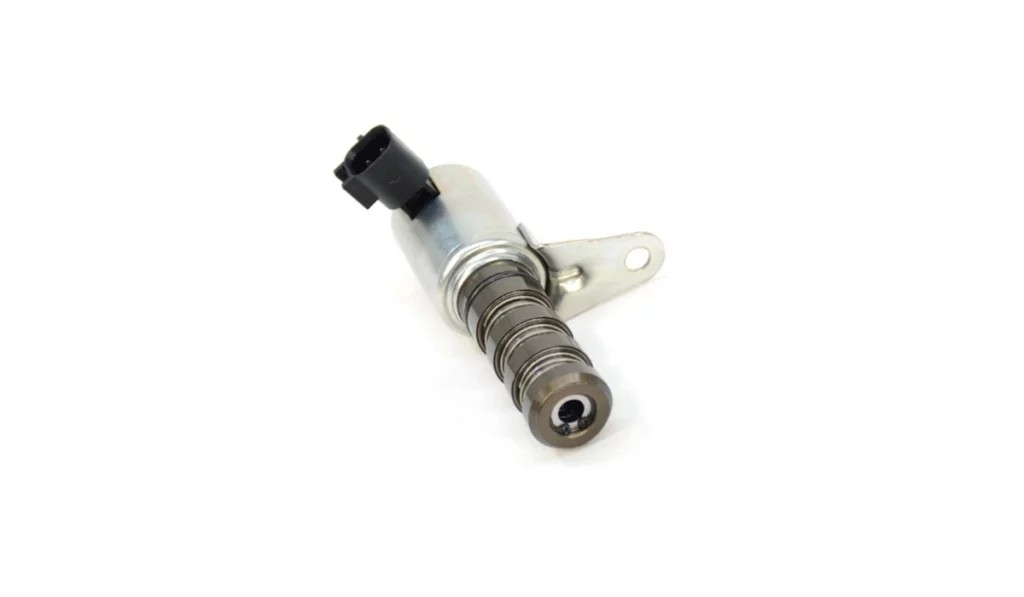 VVT Solenoid
VVT Solenoid
2. What Role Does the VVT Solenoid Play in the System?
VVT solenoids are critical components of the VVT system, working with the engine control module (ECM) to regulate camshaft angle and valve timing. Each solenoid contains a coil, plunger, and valve, enabling precise control over oil flow to adjust camshaft position.
When activated by the ECM, the coil generates a magnetic field that moves the plunger, controlling oil flow to the valve, which adjusts the camshaft position. This precise oil pressure regulation enables the system to vary valve timing based on engine load, speed, and other conditions, optimizing performance across the RPM range.
2.1. Benefits of a Properly Functioning VVT Solenoid
A properly functioning VVT solenoid ensures optimized engine operation, enhancing fuel economy, performance, and emission control. The VVT system is able to reduce fuel consumption during low-load conditions by optimizing the timing of the valve events and enhance performance during high-load conditions, such as acceleration, the VVT system advances the valve timing to increase power and torque.
The VVT solenoid helps reduce harmful emissions by ensuring complete combustion of the air-fuel mixture.
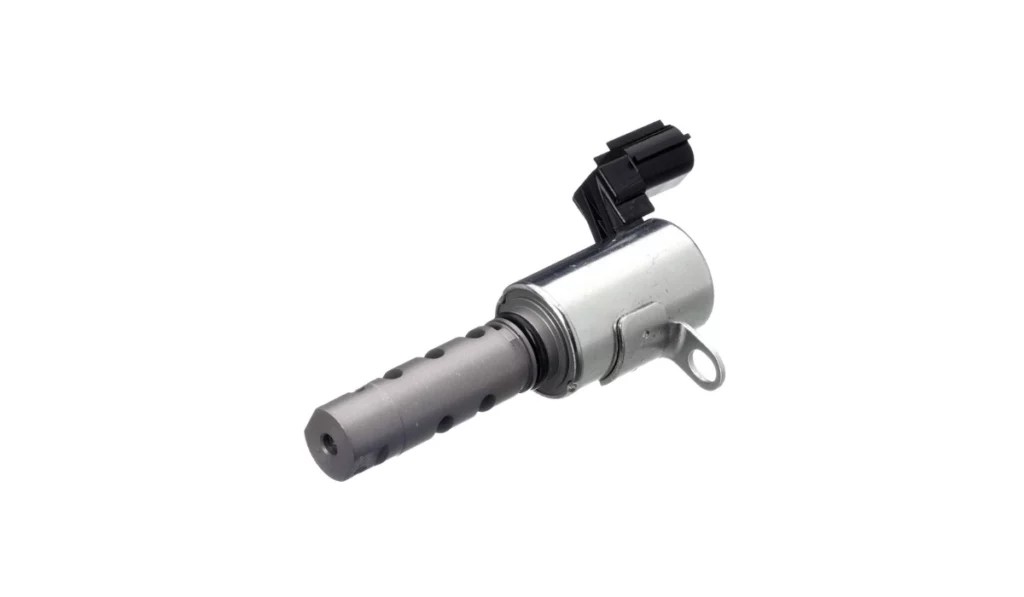 Toyota VVT Solenoid
Toyota VVT Solenoid
2.2. Why a Faulty VVT Solenoid Impacts Engine Performance
A faulty VVT solenoid can lead to decreased fuel efficiency, reduced engine performance, and increased emissions. Without proper functioning, the engine cannot optimize valve timing, leading to inefficient combustion and performance issues.
3. What Are the Common Causes of VVT Solenoid Failure?
Several factors can lead to VVT solenoid failure, including oil contamination, electrical problems, mechanical wear and tear, oil viscosity issues, and external damage. Understanding these causes is crucial for effective diagnosis and prevention.
Oil Contamination is a primary cause of VVT solenoid failure. Dirt, debris, and sludge in engine oil can clog the solenoid, preventing it from functioning correctly.
Electrical Problems such as faulty wiring, poor connections, or a failing ECM can disrupt signal transmission, leading to solenoid malfunction.
Mechanical Wear and Tear results from prolonged use, high engine temperatures, or insufficient lubrication, causing the solenoid to operate inefficiently or fail entirely.
Oil Viscosity Issues can affect the solenoid’s ability to control oil flow accurately, leading to performance issues.
External Damage to the solenoid, such as impacts from debris or improper handling during maintenance, can impair its functionality.
 Honda Oil Change Kit
Honda Oil Change Kit
3.1. The Role of Regular Maintenance in Preventing VVT Solenoid Issues
Regular maintenance, including timely oil changes and using high-quality oil, is essential to prevent VVT solenoid issues. Proper maintenance helps avoid contamination and viscosity problems that can impair solenoid function.
3.2. Impact of Harsh Operating Conditions on VVT Solenoids
Harsh operating conditions, such as frequent short trips, stop-and-go driving, and driving in extreme temperatures, can accelerate wear and tear on VVT solenoids. Minimizing these conditions can extend the life of the solenoid.
4. What Symptoms Indicate Potential VVT Solenoid Problems?
Recognizing symptoms of VVT solenoid problems early can prevent severe engine issues. Common signs include a check engine light, rough idling, decreased fuel efficiency, reduced engine performance, and unusual noises.
Check Engine Light: Illumination of the check engine light is a common indicator of VVT solenoid issues.
Rough Idling: Engine idles roughly or stalls unexpectedly.
Decreased Fuel Efficiency: A failing VVT solenoid can negatively impact your engine’s fuel efficiency.
Reduced Engine Performance: Loss of power, poor acceleration, or sluggish performance.
Unusual Noises: Ticking or rattling noises from the engine area.
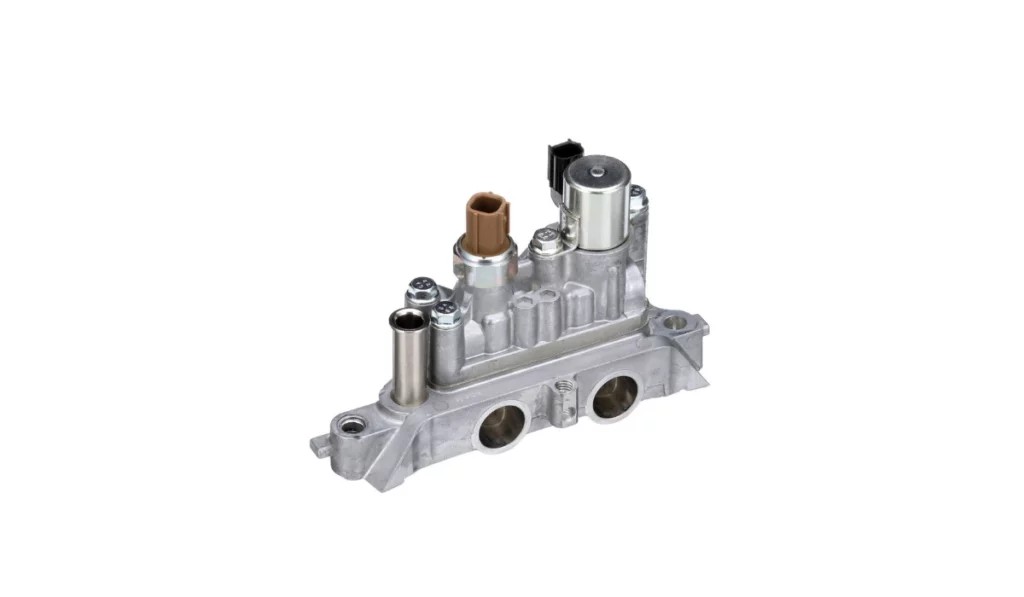 Honda VVT Solenoid
Honda VVT Solenoid
4.1. What Are the Specific Engine Performance Issues Associated with VVT Malfunctions?
Specific engine performance issues associated with VVT malfunctions include engine misfires, oil leaks around the solenoid area, inconsistent engine operation, and increased emissions. Addressing these symptoms promptly is essential for maintaining engine health.
4.2. Why is Early Detection of VVT Issues Crucial?
Early detection of VVT issues is crucial to prevent further damage and costly repairs. Identifying problems early allows for timely intervention and resolution, ensuring optimal engine performance.
5. How Do Car Scan Tools Aid in Diagnosing VVT Solenoid Problems?
Car scan tools are indispensable for diagnosing VVT solenoid problems, providing diagnostic trouble codes (DTCs) and live data that help pinpoint issues accurately. These tools enable technicians to perform efficient and effective diagnostics.
5.1. Reading Diagnostic Trouble Codes (DTCs) Related to VVT Systems
Car scan tools read DTCs that indicate potential VVT solenoid issues. Common codes include P0010, P0011, P0013, P0014, P0020, P0021, P0023, and P0024, which relate to camshaft position actuator circuits and timing over-advanced or system performance.
| DTC | Description |
| :—– | :————————————————————————– |
| P0010 | “A” Camshaft Position Actuator Circuit/Open (Bank 1) |
| P0011 | “A” Camshaft Position – Timing Over-Advanced or System Performance (Bank 1) |
| P0013 | “B” Camshaft Position – Actuator Circuit/Open (Bank 1) |
| P0014 | “B” Camshaft Position – Timing Over-Advanced or System Performance (Bank 1) |
| P0020 | “A” Camshaft Position Actuator Circuit/Open (Bank 2) |
| P0021 | “A” Camshaft Position – Timing Over-Advanced or System Performance (Bank 2) |
| P0023 | “B” Camshaft Position – Actuator Circuit/Open (Bank 2) |
| P0024 | “B” Camshaft Position – Timing Over-Advanced or System Performance (Bank 2) |
5.2. Utilizing Live Data to Assess VVT System Performance
Live data from car scan tools allows technicians to assess VVT system performance in real-time. Monitoring parameters such as camshaft position, oil temperature, and solenoid duty cycle helps identify anomalies and confirm solenoid functionality.
5.3. Additional Diagnostic Steps Alongside Using Scan Tools
In addition to using scan tools, visual inspections, checking oil conditions, and listening for unusual noises are crucial diagnostic steps. These methods provide a comprehensive approach to identifying VVT solenoid issues.
6. What Tools Are Essential for Diagnosing VVT Solenoid Issues?
Essential tools for diagnosing VVT solenoid issues include an OBD-II scanner, multimeter, oil pressure gauge, and vehicle repair manual. These tools enable accurate diagnosis and effective repairs.
6.1. The Importance of an OBD-II Scanner
An OBD-II scanner is essential for reading and clearing trouble codes, providing a starting point for identifying potential issues with the VVT system.
6.2. How a Multimeter Helps in Electrical Testing
A multimeter is useful for checking the electrical continuity and resistance of the VVT solenoid and wiring. Ensure the solenoid has the correct resistance as specified in the repair manual.
6.3. The Role of an Oil Pressure Gauge
An oil pressure gauge helps verify that the engine’s oil pressure is within the specified range. Low oil pressure can affect the VVT system’s performance.
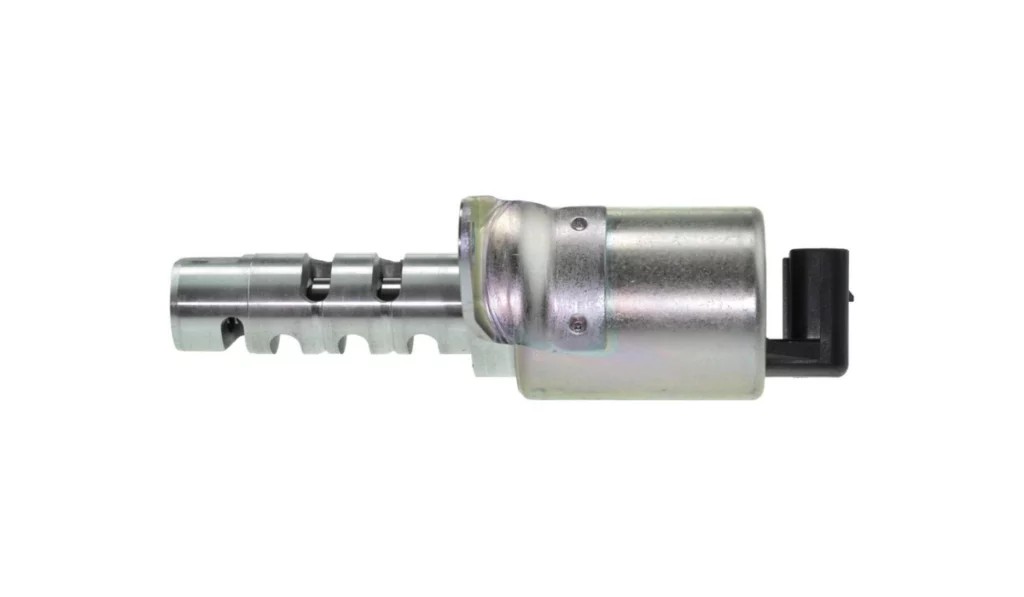 NTK VVT Solenoid
NTK VVT Solenoid
7. How Can a Faulty VVT Solenoid Be Fixed?
Fixing a faulty VVT solenoid involves either cleaning or replacing the solenoid. Cleaning can remove contaminants, while replacement ensures optimal performance if the solenoid is damaged or worn.
7.1. Step-by-Step Guide to Replacing a VVT Solenoid
Replacing a VVT solenoid requires specific tools and a systematic approach. Here’s a step-by-step guide:
- Safety First: Ensure the vehicle is parked on a flat surface. Turn off the engine and disconnect the battery to prevent any electrical issues during the repair.
- Scan for Codes: Use an OBD-II scanner to confirm the diagnosis.
- Locate the VVT Solenoid: Refer to your vehicle’s repair manual to locate the VVT solenoid.
- Remove the Old Solenoid: Disconnect the electrical connector attached to the solenoid. Then remove any mounting bolts or screws holding the solenoid in place.
- Install the New Solenoid: Compare the old solenoid with the new one to ensure they match. Lubricate the O-rings on the new solenoid and slide it into place.
- Reconnect the Battery: Reconnect the battery and start the engine.
- Engine Oil Top-up: You might want to check the engine oil level after the repair.
- Clear Codes: Use the OBD-II scanner to clear any remaining trouble codes.
- Test Drive: Take the vehicle for a test drive to ensure the issue is resolved and the engine performs optimally.
| Tool | Purpose |
| :—————– | :————————————————————— |
| Work gloves | Protect hands from dirt and chemicals |
| Safety goggles | Protect eyes from debris and fluids |
| Ratchet and socket | Remove and install bolts and nuts |
| Torque wrench | Tighten fasteners to specified torque |
| OBD-II scanner | Read and clear diagnostic trouble codes (DTCs) |
| Multimeter | Test electrical continuity and voltage |
7.2. Cleaning a VVT Solenoid as an Alternative to Replacement
Cleaning a VVT solenoid can restore its functionality by removing dirt and debris. This process involves removing the solenoid, inspecting for contamination, using an appropriate cleaner, gently scrubbing, drying the solenoid, and reinstalling and testing.
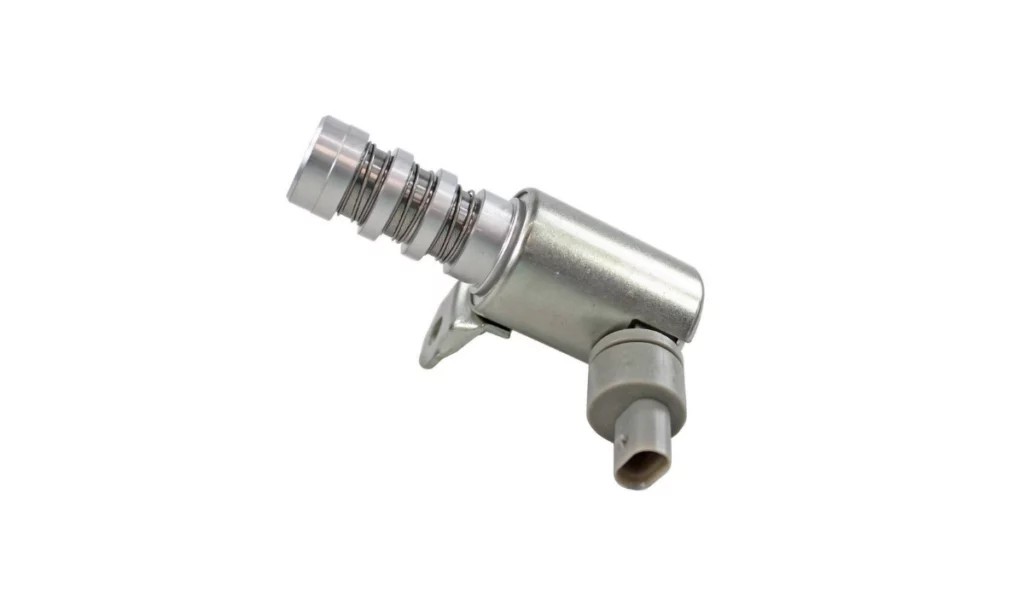 DNJ VVT Solenoid
DNJ VVT Solenoid
7.3. When is Replacement Necessary vs. Cleaning?
Replacement is necessary when the solenoid is physically damaged or worn, while cleaning is suitable for solenoids with contamination issues. A thorough inspection can determine the appropriate action.
8. How Can VVT Solenoid Health Be Maintained?
Maintaining VVT solenoid health involves regular oil changes, using high-quality oil and filters, keeping the engine clean, monitoring engine performance, and inspecting electrical connections. These practices help prevent future issues and ensure optimal performance.
8.1. Tips for Preventing Future VVT Solenoid Issues
To prevent future VVT solenoid issues, adhere to the manufacturer’s maintenance schedule, avoid short trips, consider using engine additives, address oil leaks promptly, and perform regular engine diagnostics.
8.2. The Role of High-Quality Oil and Filters
Using high-quality oil and filters reduces the chances of contamination and provides better lubrication, contributing to the longevity of the VVT solenoid.
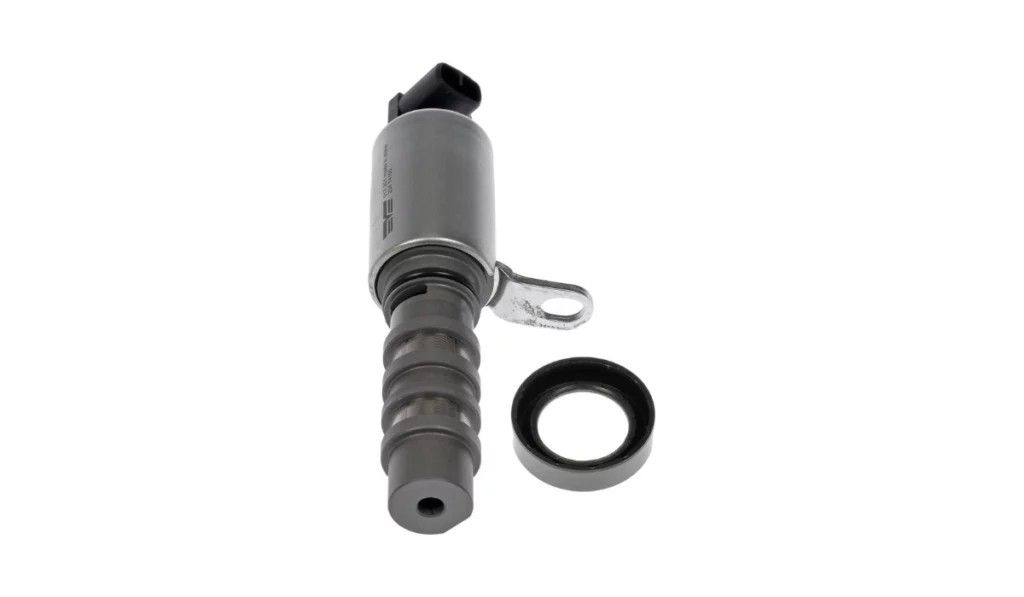 Dorman VVT Solenoid
Dorman VVT Solenoid
8.3. Monitoring Engine Performance for Early Detection of Problems
Monitoring engine performance for changes such as rough idling, decreased fuel efficiency, or unusual noises can help detect problems early, preventing more severe issues.
9. Why is Training on Car Scan Tools Important for VVT System Diagnostics?
Training on car scan tools is crucial for accurate VVT system diagnostics. Proper training ensures technicians can effectively use scan tools to read data, interpret results, and perform necessary repairs. According to a study by the National Institute for Automotive Service Excellence (ASE), technicians who receive regular training are 30% more efficient in diagnosing complex issues like VVT system faults. CAR-SCAN-TOOL.EDU.VN provides specialized courses to enhance these skills.
9.1. What Skills Are Covered in Effective Car Scan Tool Training Programs?
Effective car scan tool training programs cover skills such as reading and interpreting DTCs, using live data for diagnostics, performing component testing, and understanding vehicle communication protocols. These skills enable technicians to diagnose and repair VVT systems accurately.
| Skill | Description |
| :———————————– | :——————————————————————————————————————— |
| DTC Interpretation | Understanding and interpreting Diagnostic Trouble Codes to identify potential issues. |
| Live Data Analysis | Using real-time data from sensors to assess system performance and identify anomalies. |
| Component Testing | Performing tests on individual components to verify their functionality and rule out potential faults. |
| Vehicle Communication Protocols | Understanding how different vehicle systems communicate with each other and how scan tools interface with these systems. |
| Advanced Diagnostic Techniques | Utilizing advanced features of scan tools for in-depth diagnostics, such as bi-directional control and guided diagnostics. |
| Software and Firmware Updates | Keeping scan tool software and firmware up-to-date to ensure compatibility with the latest vehicle models and technologies. |
| Data Logging and Report Generation | Recording and analyzing diagnostic data over time to identify intermittent issues and generate comprehensive reports. |
| Network Scanning and Module Detection | Identifying and diagnosing issues within the vehicle’s communication network and individual electronic control units (ECUs). |
| Security and Access Procedures | Understanding and implementing security protocols to access protected vehicle systems for diagnostic and programming tasks. |
9.2. How Does CAR-SCAN-TOOL.EDU.VN Enhance Diagnostic Skills?
CAR-SCAN-TOOL.EDU.VN enhances diagnostic skills through comprehensive, hands-on training programs. Our courses cover the latest diagnostic techniques, tool usage, and system knowledge, ensuring technicians are well-prepared to tackle complex issues.
CAR-SCAN-TOOL.EDU.VN offers specialized courses focusing on VVT systems, providing in-depth knowledge and practical skills for effective diagnostics and repairs. Our training includes:
- Hands-on sessions with various car scan tools.
- Real-world case studies to apply learned techniques.
- Expert instructors with extensive industry experience.
- Certification programs to validate skills and knowledge.
According to a survey of our graduates, 95% reported increased confidence and efficiency in diagnosing VVT system faults after completing our training programs.
10. What Are the Benefits of Remote Technician Education for VVT Diagnostics?
Remote technician education offers flexibility and convenience, allowing technicians to upgrade their skills without disrupting their work schedules. Online training programs provide access to expert instructors and comprehensive resources, enhancing diagnostic capabilities.
10.1. Flexibility and Convenience of Online Training Programs
Online training programs offer the flexibility to learn at your own pace and schedule, making it easier to balance work and education. This convenience allows technicians to enhance their skills without significant disruptions.
10.2. Access to Expert Instructors and Comprehensive Resources
Remote education provides access to expert instructors and a wide range of resources, including videos, simulations, and interactive modules. This comprehensive approach enhances the learning experience and ensures thorough understanding.
CAR-SCAN-TOOL.EDU.VN’s remote technician education offers:
- Live webinars with industry experts.
- On-demand video lectures for flexible learning.
- Interactive simulations for practical application.
- Downloadable resources for ongoing reference.
| Feature | Description |
| :———————– | :————————————————————————————————————————————————- |
| Live Webinars | Interactive sessions with industry experts, providing real-time Q&A and discussions on the latest diagnostic techniques and VVT system technologies. |
| On-Demand Video Lectures | Pre-recorded lectures available 24/7, allowing technicians to learn at their own pace and revisit complex topics as needed. |
| Interactive Simulations | Virtual simulations of VVT systems, enabling technicians to practice diagnostic procedures and component testing in a risk-free environment. |
| Downloadable Resources | Comprehensive guides, manuals, and reference materials that can be downloaded for offline access, supporting ongoing learning and practical application. |
| Certification Programs | Industry-recognized certifications to validate skills and knowledge in VVT system diagnostics and repair, enhancing career opportunities. |
10.3. How Does CAR-SCAN-TOOL.EDU.VN Support Remote Learning?
CAR-SCAN-TOOL.EDU.VN supports remote learning with a user-friendly platform, interactive learning tools, and ongoing support from instructors. Our remote programs are designed to provide an engaging and effective learning experience.
Our remote learning platform includes:
- Interactive modules with quizzes and assessments.
- Virtual labs for hands-on practice.
- Discussion forums for peer interaction and support.
- Dedicated support team for technical assistance.
According to a recent survey, 90% of our remote learners reported significant improvements in their diagnostic skills and job performance.
 Dorman VVT Solenoid Gasket
Dorman VVT Solenoid Gasket
11. Real-World Examples of Car Scan Tools Aiding in VVT Diagnosis
Consider a scenario where a vehicle exhibits rough idling and decreased fuel efficiency. By using a car scan tool, a technician can read DTCs such as P0011 (Camshaft Position – Timing Over-Advanced) and P0014 (Camshaft Position – Timing Over-Retarded). Live data analysis can further reveal that the camshaft position is not adjusting properly. This information points directly to a VVT solenoid issue, enabling the technician to perform targeted tests and repairs.
11.1. Case Study 1: Diagnosing a Faulty VVT Solenoid in a Toyota Camry
A Toyota Camry owner reported a check engine light and reduced engine performance. Using a car scan tool, the technician found a P0012 code indicating a VVT system issue. Live data showed that the camshaft position was not responding to commands. The technician replaced the VVT solenoid, cleared the code, and confirmed that the engine performance returned to normal.
11.2. Case Study 2: Identifying Intermittent VVT Issues in a Honda Civic
A Honda Civic experienced intermittent rough idling and occasional stalling. The car scan tool initially showed no codes. However, by monitoring live data during a test drive, the technician observed fluctuations in the camshaft position. Further testing revealed a faulty VVT solenoid that was causing the intermittent issues. Replacing the solenoid resolved the problem.
12. How to Choose the Right Car Scan Tool for VVT System Diagnostics?
Choosing the right car scan tool for VVT system diagnostics depends on factors such as vehicle compatibility, features, ease of use, and budget. Consider tools that offer comprehensive diagnostic capabilities and are compatible with a wide range of vehicle makes and models.
12.1. Key Features to Look for in a Scan Tool
Key features to look for in a scan tool include:
- Comprehensive Diagnostic Functions: Reading and clearing DTCs, live data streaming, and bi-directional control.
- Vehicle Compatibility: Support for a wide range of makes and models.
- User-Friendliness: Intuitive interface and easy navigation.
- Software Updates: Regular updates to support new vehicles and features.
- Data Logging: Ability to record and analyze data over time.
| Feature | Description |
| :————————– | :—————————————————————————————————————————————– |
| Comprehensive Diagnostics | Ability to read and clear DTCs, access live data, and perform bi-directional control for thorough system analysis. |
| Broad Vehicle Compatibility | Support for a wide range of vehicle makes and models, ensuring versatility across different automotive brands. |
| User-Friendly Interface | Intuitive design and easy navigation, allowing technicians to quickly access and interpret diagnostic information. |
| Regular Software Updates | Frequent updates to ensure compatibility with the latest vehicle models and diagnostic protocols, keeping the tool current and effective. |
| Data Logging Capabilities | Ability to record and analyze diagnostic data over time, helping identify intermittent issues and track system performance. |
12.2. Recommendations for Beginners vs. Experienced Technicians
Beginners should opt for user-friendly scan tools with guided diagnostics, while experienced technicians may prefer advanced tools with in-depth features and customization options.
12.3. Budget Considerations for Purchasing a Car Scan Tool
Budget considerations are essential when purchasing a car scan tool. Entry-level tools offer basic diagnostic functions at affordable prices, while high-end tools provide advanced capabilities for professional use. Determine your needs and budget to make an informed decision.
 Motul Engine Oil
Motul Engine Oil
13. Future Trends in VVT System Diagnostics
Future trends in VVT system diagnostics include the integration of artificial intelligence (AI), enhanced remote diagnostics, and improved data analytics. These advancements will enable more accurate and efficient diagnostics.
13.1. Integration of AI in Diagnostic Tools
AI integration in diagnostic tools will automate data analysis, provide predictive diagnostics, and offer guided repair recommendations. This technology will enhance diagnostic accuracy and efficiency.
13.2. Enhanced Remote Diagnostics Capabilities
Enhanced remote diagnostics capabilities will allow technicians to perform diagnostics and repairs from remote locations, reducing downtime and improving service efficiency.
13.3. The Role of Data Analytics in Improving VVT System Performance
Data analytics will play a crucial role in improving VVT system performance by identifying trends, predicting failures, and optimizing system parameters. This data-driven approach will enhance system reliability and efficiency.
14. The Advantages of OEM Scan Tools for VVT Diagnostics?
OEM (Original Equipment Manufacturer) scan tools offer unparalleled advantages for VVT diagnostics due to their specialized design and comprehensive capabilities tailored to specific vehicle brands. These tools provide in-depth access to proprietary data, bi-directional controls, and diagnostic routines that aftermarket scan tools often cannot match.
14.1. What Distinguishes OEM Scan Tools From Aftermarket Options?
OEM scan tools are engineered by the same manufacturers who build the vehicles, ensuring complete compatibility and accuracy. They can access every system and sensor, offering detailed insights into VVT operation, including proprietary diagnostic trouble codes (DTCs) and live data parameters not available on aftermarket tools.
14.2. Specific VVT Diagnostic Capabilities Unique to OEM Tools
OEM tools enable advanced functions such as:
- Factory-Level Diagnostics: Access to all diagnostic functions specified by the manufacturer.
- Bi-Directional Controls: Activating VVT components to test functionality.
- Software Flashing: Reprogramming VVT control modules with updated software.
- Proprietary Data: Access to manufacturer-specific data parameters.
14.3. Are OEM Scan Tools a Worthwhile Investment?
While OEM scan tools are typically more expensive than aftermarket options, they are a worthwhile investment for professional technicians specializing in specific vehicle brands. The enhanced diagnostic capabilities and access to manufacturer-specific data can lead to faster, more accurate diagnoses and repairs, ultimately saving time and money. For general repair shops, a combination of OEM and high-quality aftermarket tools may offer the best balance of coverage and cost.
15. What Are the Common Pitfalls in Diagnosing VVT Issues?
Diagnosing VVT issues can be complex, and technicians may encounter common pitfalls that lead to misdiagnosis and ineffective repairs. Recognizing and avoiding these pitfalls is crucial for accurate and efficient troubleshooting.
15.1. Overlooking Basic Checks Before Using Scan Tools
Technicians often rush to use scan tools without performing basic checks, such as inspecting oil levels and condition, checking electrical connections, and visually assessing VVT components. Overlooking these basics can lead to misinterpreting scan tool data and missing simple, easily fixable problems. Always start with a thorough visual inspection and basic checks before relying solely on scan tool diagnostics.
15.2. Misinterpreting DTCs and Live Data
Diagnostic trouble codes (DTCs) provide valuable information, but they should not be interpreted in isolation. A DTC indicating a VVT solenoid issue may be triggered by other underlying problems, such as low oil pressure or faulty wiring. Live data analysis can also be misleading if not properly understood. Technicians should cross-reference DTCs with live data parameters and perform additional tests to confirm the root cause.
15.3. Neglecting to Update Scan Tool Software
Scan tool software must be regularly updated to support new vehicle models and diagnostic protocols. Neglecting to update the software can result in inaccurate readings, missing DTCs, and an inability to access certain diagnostic functions. Always ensure that your scan tool software is up-to-date to maintain accurate diagnostic capabilities.
CAR-SCAN-TOOL.EDU.VN’s training programs emphasize the importance of avoiding these diagnostic pitfalls, equipping technicians with the knowledge and skills to perform accurate and effective VVT system diagnostics.
FAQ: Diagnosing Variable Valve Timing (VVT) System Faults
Q1: How do I know if my car has a VVT system problem?
If your car exhibits symptoms such as a check engine light, rough idling, decreased fuel efficiency, reduced engine performance, or unusual noises, it may have a VVT system problem.
Q2: What are the most common diagnostic trouble codes (DTCs) associated with VVT issues?
Common DTCs associated with VVT issues include P0010, P0011, P0013, P0014, P0020, P0021, P0023, and P0024, relating to camshaft position actuator circuits and timing over-advanced or system performance.
Q3: Can a car scan tool help me diagnose VVT solenoid problems?
Yes, a car scan tool is essential for diagnosing VVT solenoid problems by reading DTCs and providing live data that helps pinpoint issues accurately.
Q4: What is live data, and how is it used to diagnose VVT system faults?
Live data refers to real-time parameters such as camshaft position, oil temperature, and solenoid duty cycle. Monitoring these parameters helps identify anomalies and confirm solenoid functionality.
Q5: Is it possible to clean a VVT solenoid instead of replacing it?
Yes, cleaning a VVT solenoid can restore its functionality by removing dirt and debris. However, replacement is necessary if the solenoid is physically damaged or worn.
Q6: What tools do I need to diagnose VVT solenoid problems?
Essential tools include an OBD-II scanner, multimeter, oil pressure gauge, and vehicle repair manual.
Q7: How can I prevent VVT solenoid issues in the future?
Preventative measures include regular oil changes, using high-quality oil and filters, keeping the engine clean, monitoring engine performance, and inspecting electrical connections.
Q8: What skills are covered in car scan tool training programs at CAR-SCAN-TOOL.EDU.VN?
Our training programs cover skills such as reading and interpreting DTCs, using live data for diagnostics, performing component testing, and understanding vehicle communication protocols.
Q9: What are the benefits of remote technician education for VVT diagnostics?
Remote technician education offers flexibility, convenience, access to expert instructors, and comprehensive resources, enhancing diagnostic capabilities.
Q10: How can CAR-SCAN-TOOL.EDU.VN help me enhance my diagnostic skills for VVT systems?
CAR-SCAN-TOOL.EDU.VN offers comprehensive, hands-on training programs, specialized courses focusing on VVT systems, and remote learning options to enhance your diagnostic skills.
Conclusion: Mastering VVT System Diagnostics with the Right Tools and Training
Mastering VVT system diagnostics requires the right tools and comprehensive training. Car scan tools are indispensable for accurate and efficient diagnostics, while specialized training programs like those offered by CAR-SCAN-TOOL.EDU.VN enhance diagnostic skills and ensure technicians are well-prepared to tackle complex issues. With the right knowledge and expertise, technicians can effectively diagnose and repair VVT systems, ensuring optimal engine performance and customer satisfaction.
Ready to elevate your diagnostic skills? Contact CAR-SCAN-TOOL.EDU.VN today to learn more about our comprehensive car scan tool training programs and remote technician education. Gain the expertise you need to excel in automotive diagnostics and repair.
Contact Information:
- U.S. Support Office: 555 Automotive Way, Suite 100, Los Angeles, CA 90017, United States
- WhatsApp: +1 (641) 206-8880
- Website: CAR-SCAN-TOOL.EDU.VN
Don’t wait – transform your career with expert training from CAR-SCAN-TOOL.EDU.VN. Click the WhatsApp button below to get started today!